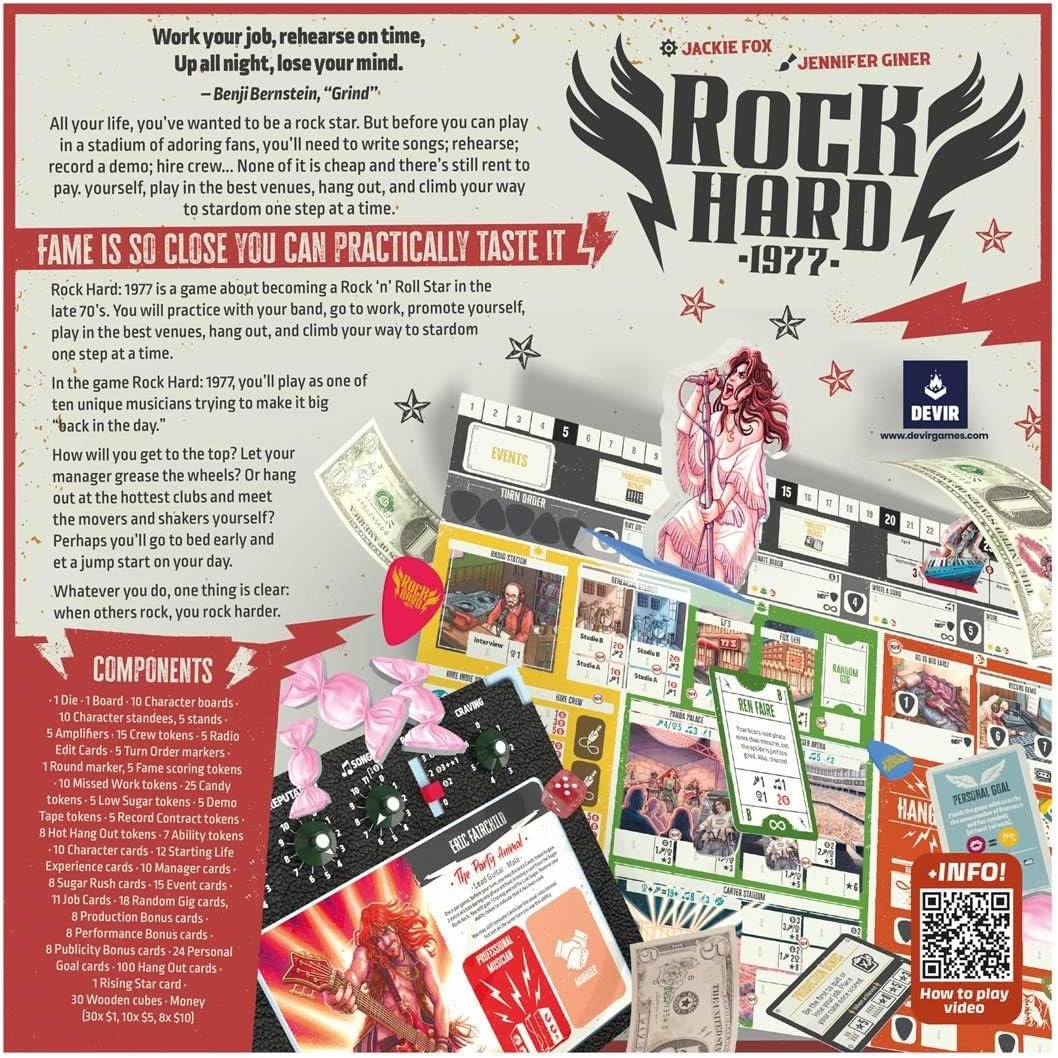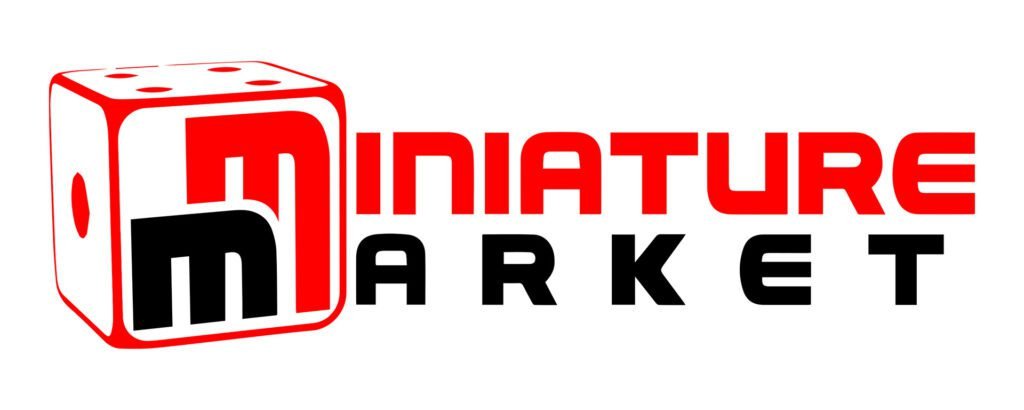
Today we’re diving into “Rock Hard: 1977,” a board game that transports players back to the vibrant rock music scene of the late 1970s. Designed by Jackie Fox, a former member of the all-female rock band The Runaways, the game offers a unique & immersive experience for aspiring rock stars. So, let’s break it down – what it is, what’s good, what’s bad, & if you should pick it up. Let’s get into it.

What It Is
“Rock Hard: 1977” is a worker placement game where players step into the shoes of aspiring rock musicians navigating the highs & lows of the late 70s rock scene. This game blends strategic decision-making with a deep thematic connection to the era. It’s for 2-5 players & typically takes about 90 minutes to play. The game is divided into phases—daytime, nighttime, & after-hours—each offering different opportunities to improve stats, secure record deals, & perform gigs to earn Fame points.
Gameplay Overview
In Rock Hard: 1977, players will need to balance their day-to-day jobs, build their musical talents, secure a record deal, and play gigs while navigating the wild nightlife. The objective is to gain the most fame, and after nine rounds or when a player reaches 50 fame, the one with the highest fame wins.
To set up, players will use different sides of the board depending on the number of participants. Cards and resources are laid out, including event cards and public scoring objectives, which players will compete to achieve. The game also includes a randomized gig deck and various hangout tokens that determine the hottest spots in town. Each player receives an amp board, setting their base stats and resources, and chooses a character card with unique powers. Players will also select personal goals and job cards that will dictate their income until they can fully commit to their rockstar career.
Rock Hard: 1977 is played over nine rounds, each representing a day in the life of the rock star. Each round starts with a prep phase where a new event card is revealed, and a gig card is drawn. The core gameplay consists of three worker placement phases: the day phase, night phase, and after-hours phase. Players will take turns placing their standees on available action spaces, each offering different benefits such as working a job, rehearsing, promoting their band, or playing gigs. Some actions are limited to one player, while others are open to multiple players, with a unique anytime action option allowing flexibility.
Writing songs is a crucial part of the game, as it boosts your stats and helps progress your music career. Players must also work to earn money, especially early in the game, as they won’t make enough from music alone. Jobs can vary, with some requiring luck or specific timing to maximize earnings. If a player fails to work when required, they receive missed work tokens, and after accumulating three, they lose their job, making it crucial to manage time and resources effectively.
Candy plays a significant role in Rock Hard: 1977, serving as a resource to take extra actions during the game. Consuming candy triggers a sugar rush, allowing players to perform additional actions within a phase. However, this comes with the risk of a sugar crash, which could limit a player’s options in subsequent rounds. Candy management becomes a strategic element, especially when balancing the need for extra actions against the potential penalties of crashing.
The journey to stardom also involves promoting your music and securing a record deal. Players can engage in radio interviews, hire publicists, and eventually sign a record deal that boosts their income and fame. Night phases are dedicated to playing gigs, with more prestigious venues requiring additional resources such as crew members and higher stats. The ultimate goal is to perform at the biggest venues, culminating in a high-scoring gig at Carter Stadium, which requires significant preparation and resources.
Finally, the after-hours phase lets players chase fame at popular hangout spots, collecting cards that contribute to set collection objectives. Players can also use their managers’ abilities, complete personal goals, or score public bonuses. As the game progresses, managing turn order becomes critical, especially if players want the best positions in the next round.
The game concludes after nine rounds, with players tallying their fame, including bonuses for maxed-out stats, leftover money, and penalties for sugar crashes. The player with the highest score wins, with ties broken by reputation, money, and royalties.
The Components
One of the first things you’ll notice about “Rock Hard: 1977” is its production quality. The game boasts high-quality components, including amplifier-inspired player boards with dials, paper money, & vibrant artwork that perfectly captures the spirit of the 70s rock scene. The use of dials on the player boards is a particularly clever design choice, making it easy to track key stats & adding to the game’s tactile appeal.
However, there are some minor usability issues with the components. The small size of certain icons can be difficult to read, especially from different angles, which could be a concern for players with visual impairments or those playing in dimly lit environments.

The Good
First off, let’s talk about the thematic strength. “Rock Hard: 1977” excels in integrating its theme into every aspect of the game. The components, such as the amplifier-inspired player boards & the references to the challenges of the rock lifestyle, create an authentic rock & roll atmosphere. The designer’s personal experience as a musician lends a layer of authenticity that really brings the theme to life.
The gameplay mechanics are engaging, with the worker placement system offering a satisfying blend of strategy & thematic immersion. The inclusion of personal objectives & unique manager abilities adds replayability & keeps each game fresh. The variety of phases—daytime, nighttime, & after-hours—adds depth to the decision-making process, making the game more than just a straightforward worker placement experience.
The Bad
However, the game isn’t without its drawbacks. One issue is the linearity of the gameplay. While the thematic integration is strong, the clear progression path can make the game feel a bit on rails. This might limit the variety of strategies players can employ, making the game feel repetitive after multiple plays.
Randomness also plays a significant role in “Rock Hard: 1977.” The card flips, including those for candy, events, & after-hours activities, can introduce a level of unpredictability that some players might find frustrating. If you prefer a game with more controlled, deterministic outcomes, this aspect could be a downside.
Another point to consider is the production quality, specifically the usability of certain components. The small size of some icons can be difficult to read, which might be problematic in certain lighting conditions or for players with visual impairments.
The Verdict
So, should you buy “Rock Hard: 1977”? If you’re a fan of the 70s rock scene or love games with strong thematic integration, this one is definitely worth checking out. The game offers a unique & immersive experience that’s both engaging & visually appealing. The production quality is high, & the gameplay mechanics, while not the deepest, provide a fun & thematic experience.
For fans of worker placement games, “Rock Hard: 1977” is a solid addition to your collection, especially if you appreciate games that blend strategy with a rich theme. However, if you prefer games with less randomness & more open-ended strategic depth, you might find this one a bit limiting.
Final Thoughts
After spending some time with Rock Hard 1977, I can confidently say that it’s a game with a lot of heart, but it’s not going to be for everyone. The game does a great job of putting you in the shoes of a struggling musician trying to make it big. You’re not just handed success; you have to earn it by grinding through the daily grind & scraping together cash wherever you can, even if it means making some questionable decisions. The game really captures that feeling of slow progress with moments of hope sprinkled in, which fits the theme perfectly.
The unpredictability in Rock Hard 1977 adds a layer of excitement to the game. You never quite know what’s going to happen next, & that’s where the game shines for players who enjoy a bit of chaos. A lucky break could be right around the corner, or a setback could throw a wrench in your plans. It keeps you on your toes & makes each playthrough feel fresh & different.
However, this randomness is a double-edged sword. While it adds excitement, it can also be frustrating for those who prefer more strategic control. If you’re the type of player who likes to carefully plan your moves & execute a well-thought-out strategy, the random events might feel more like a hindrance than a fun twist. It’s the kind of game where a single unexpected event can completely derail your progress, which can be a dealbreaker for some.
What Rock Hard 1977 does exceptionally well is its dedication to the rock & roll theme. Everything about the game—from the artwork to the mechanics—feels like it was designed with a deep love for music. It’s clear that a lot of personal experience & passion went into creating this game, & that shines through in every aspect. If you’ve ever wanted to live the life of a rock star, this game offers a fun, if sometimes harsh, way to experience that.
Ultimately, Rock Hard 1977 is a game that’s going to appeal to a specific type of player. If you love thematic games that don’t shy away from incorporating elements of luck & chance, & if you’re a fan of music, this game is worth checking out. On the other hand, if you prefer more control & less randomness in your games, you might find this one more frustrating than fun. For me, it’s a game I’ll pull out when I want to feel the ups & downs of a rock star’s journey & share that experience with friends who appreciate a good thematic experience.
Purchase Options


At no extra cost to you, The Board Game Site may receive revenue from affiliate and advertising partnerships for sharing this content and from purchases through links.








